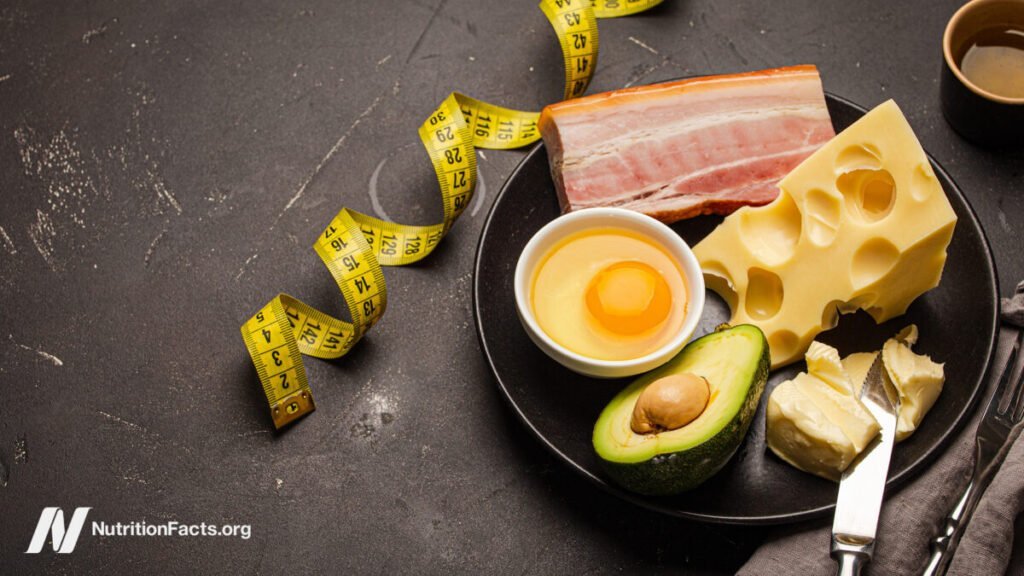[ad_1]
Let’s explore ketogenic eating plans and their $33-billion marketing scheme.
The carbohydrate–insulin model of obesity, the fundamental theory that ketogenic diets possess some form of metabolic benefit, has been experimentally disproven. Studies conducted by proponents of the keto diet revealed the exact opposite: Ketogenic diets actually put you at a metabolic disadvantage and impede the reduction of body fat. How much does fat loss slow down on a low-carb diet?
As explained in my video Keto Diet Results for Weight Loss, if you eliminate about 800 calories of carbohydrates from your daily diet, you lose 53 grams of body fat each day. However, if you cut the same number of fat calories, you shed 89 grams of fat daily. Same calorie reduction, but nine butter pats’ worth of additional fat melting off your body each day on a low-fat regimen, compared to a low-carb one. Same calorie count, but about 80 percent more fat loss when you reduce fat instead of carbs. You can view a visual representation of these findings below and at 1:07 in my video. The study’s title speaks for itself: “Calorie for Calorie, Dietary Fat Restriction Results in More Body Fat Loss Than Carbohydrate Restriction in People with Obesity.”

However, simply relying on the bathroom scale would lead to a misunderstanding. After six days on the low-carb diet, participants shed four pounds. On the low-fat diet, they lost less than three pounds, as depicted in the graph below and at 1:40 in my video. Hence, based on the scale, it appeared that the low-carb diet reigned supreme. This explains the high popularity of low-carb diets. However, what was happening internally within their bodies tells the real story. The low-carb group was primarily losing lean mass—water and protein. This decrease in water weight helps clarify why low-carb diets have “been such a persistent theme for authors of diet books and such lucrative ventures for publishers,” going back over the past 150 years. That’s their secret. As noted by one weight-loss expert, “Swift water loss is the $33-billion diet gimmick.”

When you consume carbohydrates, your body stores glycogen in your muscles for rapid energy. Adhering to a high-carbohydrate diet for three days may result in an increase of about three pounds of muscle mass in your arms and legs, as depicted below and at 2:34 in my video. Those glycogen reserves deplete on a low-carb diet and draw water out with it. (The kidneys also need to flush out the ketones, expelling even more water.) On the scale, this may manifest as an additional four pounds shedding within ten days, but all of that “was accounted for by reductions in total body water”—meaning water loss.

Ultimately, keto diets simply do not retain water.
The excitement of observing the pounds shed off rapidly on the scale entices many individuals to return to the low-carb approach. When the diet proves ineffective, the dieters often place blame on themselves, but the allure of that initial, swift weight loss may sway them back, reminiscent of getting inebriated again after forgetting how undesirable the last hangover was. This phenomenon has been labeled the “false hope syndrome.” “The diet industry flourishes for two reasons—grand assurances and repeat customers,” something low-carb diets were tailored for, given the initial, rapid water loss.
What truly matters is body fat. In six days, the low-fat diet eliminated a total of 80 percent more fat from the body than the low-carb diet. It’s not a solitary study either. AsSee below and at 3:54 in my video, you can view all the controlled feeding experiments where scientists contrasted low-carb diets with low-fat ones, exchanging an equal amount of carb calories for fat calories or vice versa. If every calorie is simply equal, then all of the investigations should have intersected the midpoint, balancing “favors low-fat diet” and “favors low-carb diet,” and certainly six did. A single investigation revealed more fat reduction on a low-carb diet, however, each and every other study preferred the low-fat diet—greater reduction of body fat while consuming the same amount of calories. When all of the investigations are combined, we’re talking about 16 more grams of daily body fat lost on the low-fat diets. That’s comparable to four more pats of butter melting off your body every day. Reduced fat intake means diminished hip fat, even when the identical number of calories is being consumed.
 This article represents the third part of my seven-section series on keto diets.
This article represents the third part of my seven-section series on keto diets.
This keto research was sourced from the extensive research I undertook for my book How Not to Diet. (All profits I receive from my books are contributed to charitable causes.) You can find out more about How Not to Diet and purchase it here. Also, feel free to explore some of my popular weight-loss videos in the related videos below.
[ad_2]


